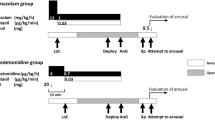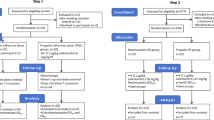Abstract
The authors analyzed and compared the cardiovascular effects of two anesthetic combinations in minipigs undergoing open-heart surgery and cardiopulmonary bypass. Pigs in group K (n = 15) were anesthetized with low-dose ketamine combined with pentobarbital (5 mg per kg and 20 mg per kg, respectively, for induction; continuous intravenous infusion of 5 mg per kg per h and 10 mg per kg per h, respectively, for maintenance). Pigs in group F (n = 15) were treated with fentanyl and pentobarbital (20 μg per kg and 20 mg per kg, respectively, for induction; continuous intravenous infusion of 20 μg per kg per h and 10 mg per kg per h, respectively, for maintenance). Most pigs remained stable during the surgical procedures and survived for at least one day after surgery; two pigs in group F died during or soon after surgery. Heart rate and mean arterial pressure after bypass were significantly lower in group F than in group K, and pigs in group F required higher doses of inotropic agents to maintain cardiac function. Results suggest that for open-heart surgery and bypass in minipigs, ketamine-pentobarbital anesthesia is associated with more stable cardiovascular conditions than is fentanyl-pentobarbital anesthesia.
This is a preview of subscription content, access via your institution
Access options
Subscribe to this journal
We are sorry, but there is no personal subscription option available for your country.
Buy this article
- Purchase on Springer Link
- Instant access to full article PDF
Prices may be subject to local taxes which are calculated during checkout


Similar content being viewed by others
References
Adams, H.A. [S-(+)-ketamine. Circulatory interactions during total intravenous anesthesia and analgesia-sedation; article in German]. Anaesthesist 46, 1081–1087 (1997).
Goldmann, C. et al. Combination anesthesia with ketamine and pentobarbital: a long-term porcine model. Res. Exp. Med. (Berl.) 199, 35–50 (1999).
Institute for Laboratory Animal Research, National Research Council. Guide for the Care and Use of Laboratory Animals (National Academies Press, Washington, DC, 1996).
Schumann, R.E., Swindle, M.M., Knick, B.J., Case, C.L. & Gillette, P.C. High-dose narcotic anesthesia using sufentanil in swine for cardiac catheterization and electrophysiologic studies. J. Invest. Surg. 7, 243–248 (1994).
Swindle, M.M. et al. Anatomic and anesthetic considerations in experimental cardiopulmonary surgery in swine. Lab. Anim. Sci. 36, 357–361 (1986).
Shimada, M., Winchurch, R.A., Beloucif, S. & Robotham, J.L. Effect of anesthesia and surgery on plasma cytokine levels. J. Crit. Care 8, 109–116 (1993).
Strom, J., Haggmark, S., Reiz, S. & Sorensen, M.B. Cardiovascular effects of pentobarbital in pigs, and the lack of response to naloxone in pentobarbital induced circulatory failure. Acta Anaesthesiol. Scand. 31, 413–416 (1987).
Grund, F., Tjomsland, O., Sjaastad, I., Ilebekk, A. & Kirkeboen, K.A. Pentobarbital versus medetomidine-ketamine-fentanyl anaesthesia: effects on haemodynamics and the incidence of ischaemia-induced ventricular fibrillation in swine. Lab. Anim. 38, 70–78 (2004).
Hubert, M.B., Salazkin, I., Desjardins, J. & Blaise, G. Cardiopulmonary bypass surgery in swine: a research model. J. Exp. Anim. Sci. 43, 135–149 (2003).
Mazzadi, A.N. et al. Mechanisms leading to reversible mechanical dysfunction in severe CAD: alternatives to myocardial stunning. Am. J. Physiol. Heart Circ. Physiol. 291, H2570–H2582 (2006).
Parasher, P.S. & Daher, I.N. Myocardial recovery after hypoxia: stunning recovery. Echocardiography 25, 1011–1013 (2008).
Hue, L. & Rider, M.H. Role of fructose 2,6-bisphosphate in the control of glycolysis in mammalian tissues. Biochem. J. 245, 313–324 (1987).
Acknowledgements
This study was supported by grant number 30772152 from the National Natural Science Foundation of China.
Author information
Authors and Affiliations
Corresponding author
Ethics declarations
Competing interests
The authors declare no competing financial interests.
Rights and permissions
About this article
Cite this article
Liu, D., Shao, Y., Luan, X. et al. Comparison of ketamine-pentobarbital anesthesia and fentanyl-pentobarbital anesthesia for open-heart surgery in minipigs. Lab Anim 38, 234–240 (2009). https://doi.org/10.1038/laban0709-234
Received:
Accepted:
Issue Date:
DOI: https://doi.org/10.1038/laban0709-234



